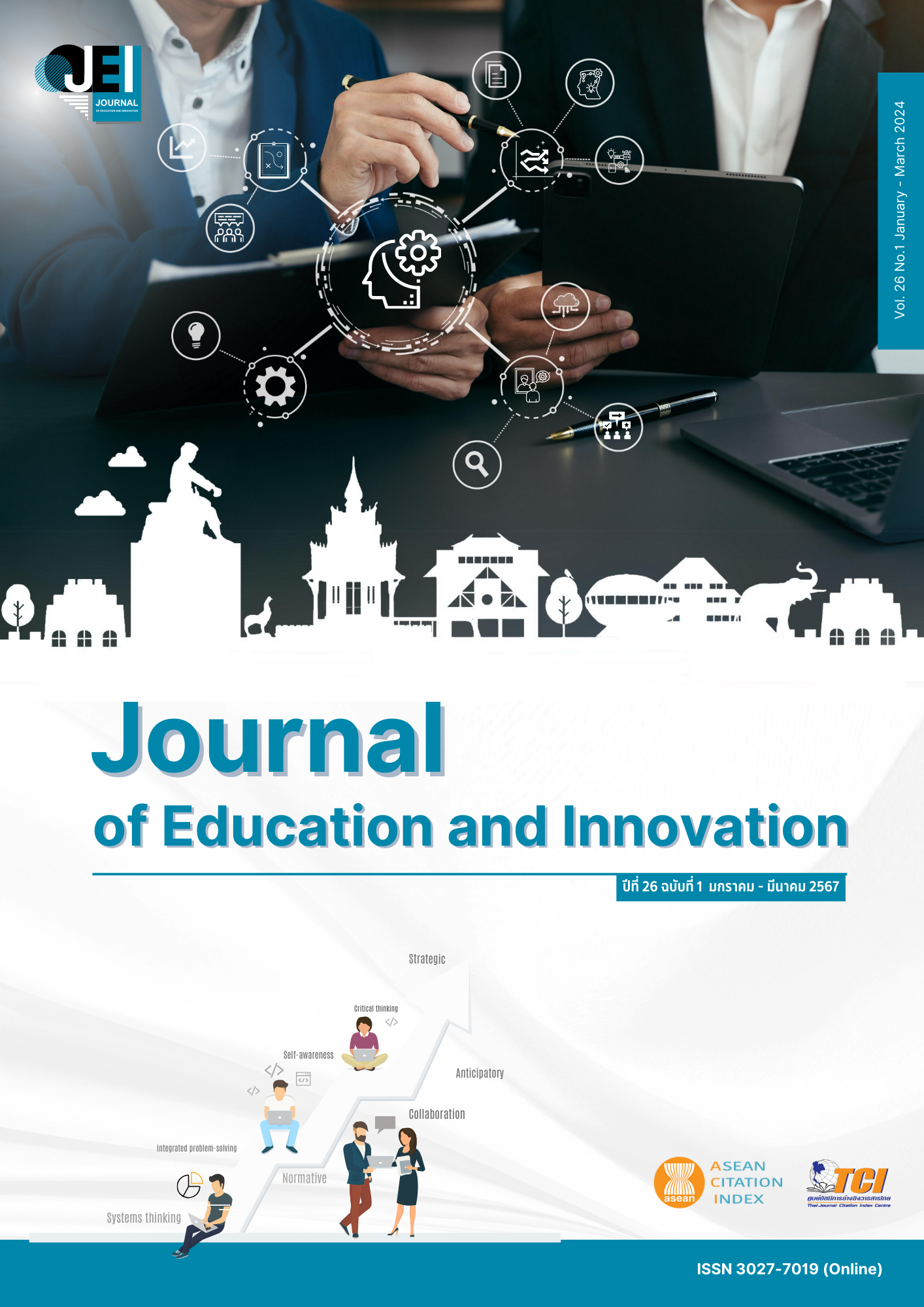A COMPARISON OF CREATIVE LEADERSHIP OF SCHOOL ADMINNISTRATORS AS PERCEIVED BY TEACHERS IN SCHOOL UNDER THE SECONDARY EDUCATIONAL SERVICE AREA OFFICE SAMUT PRAKAN
Main Article Content
Abstract
The purposes of this research aimed to examine and compare the levels of the creative leadership of school administrators as perceived by teachers under the Secondary Educational Service Area Office, Samut Prakan in academic year 2022, classified by educational background, position/academic standing, and school size. The study sample consisted of 299 teachers were categorized by using the Cohen’s sample size, and multi-stage random sampling. The research instrument was a questionnaire querying teacher’s about the levels of the creative leadership of school administrators. The questionnaire’s reliability was 0.982. Mean, standard deviation, t-test, one-way ANOVA, and Scheffé’s multiple comparison method were used to analyzed the data. Findings were as follows: 1) the result of creative leadership of school administrators both with the overall opinion and in each dimension were at the highest level, and 2) the results creative leadership comparison’s level of school administrators can be summarized as follows: the opinion of creative leadership’s levels of school administrators with different level of education was found to be no different, except the opinions about motivation was different at the significant level of 0.05. The opinion about creative leadership’s levels of school administrators with different position/academic standing was found to be different at the significant level of 0.05, except the opinion about motivation was found to be no different. The opinion of creative leadership’s level of school administrators with different school size was found to be no different, both with the overall opinion and in each dimension.
Article Details

This work is licensed under a Creative Commons Attribution-NonCommercial-NoDerivatives 4.0 International License.
The owner of the article does not copy or violate any of its copyright. If any copyright infringement occurs or prosecution, in any case, the Editorial Board is not involved in all the rights to the owner of the article to be performed.
References
Abdul, K. (2007). Creative leadership in the global knowledge economy. Retrieved from Availablehttp://www.india.jbs.cam.ac.uk/news/events/2009/ 090603_abdul_kalarm.html
Adipat, S. (2022). The world of technology: Artificial intelligence in education. Proceedings of International Conference on Social Science and Humanities, Science Society (pp. 46–48). Paris, France.
Adipat, S., Chotikapanich, R., Laksana, K., & Busayanon, K. (2023). Technological pedagogical content knowledge for professional teacher development. Academic Journal of Interdisciplinary Studies, 12(1), 173-182.
Amable, T. M. (1999). How to kill creativity. Harvard Business Review on breakthrough thinking. Cambridge MA: Harvard University Press.
Bennis, W. (2002). Creative leadership. Bangkok: Chulalongkorn University.
Chernin, P. (2001). Creative leadership: The strength of ideas the power of the Imagination. Vital Speeches of the Day, 68(8), 245.
Cohen, L., Manion, L., & Morrison, K. (2011). Research method in education (7th ed.). New York: Morrison.
Dokmai, P. (2017). The influences of administrator’s creative leadership on the effectiveness of learning management in the 21st Century of Schools under the Secondary Education Service Area Office 26 (Master thesis). Nonthaburi: Sukhothai Thammathirat University.
Hoy, W., & Miskel, C. (2001). Educational administration: Theory, research and practice (6th ed.). New York: McGraw-Hill.
Katz, J. A. (2003). The chronology and intellectual trajectory of American entrepreneurship education: 1876-1999. Journal of Business Venturing, 18, 283-300.
Khuanramphung, M. (2021). The creative leadership of the school administrators in opportunity expansion school, Krabi Primary Educational Service Area Office. Journal of Buddhistic Sociology, 6(3), 17-32.
Mungkasem, U. (2001). The experimental chief executive officer (Doctoral dissertation). Philippines: Graduate School Technical University of the Philippines.
Office of The Education Council. (2017). National Education Plan in 2017-2036. Bangkok: Prikhwan Graphic.
Parker, J. P., & Begnaud, L. G. (2004). Developing creative leadership. Portsmouth, NH: Teacher Ideas.
Piatanom, P. (2020). Educational Leadership in Disruption Era with Thailand Educational Directions. Journal of Humanities and Social Science Nakhon Phanom University, 10(3), 115-123.
Phetsombat, P. (2017). Leadership and Human Resource Development. Journal of MCU Social Development, 2(1), 1-10.
Pimkham, P. (2012). Administrators’ Creative Leadership Affecting School Effectiveness under Nakhon Phanom Primary Educational Service Area Office 2. Journal of Educational Administration and Leadership, 10(40), 91-101.
Renshaw, J. (2016). Formative Leadership. Retrieved from https://www.linkedin.com/-pulse/formative-leadership-jason-renshaw
Rodkhwan, L. (2022). Creative leadership of administrators as perceive by teachers in Southern Rajaprajanugroh Schools Under the Special Education Administration Bureau Group 7. Journal of Educational Management and Research Innovation, 4(2), 151-162.
Rovinelli, R. J., & Hambleton, R. K. (1977). On the use of content specialists in the assessment of criterion-referenced test item validity. Dutch Journal of Educational Research, 2, 49-60.
Siratanita, V. (2020). A development of creative leadership for school administrators in Lower North-Eastern Region. UMT-Poly Journal, 17(1), 69-79.
Somboonsirorat, S. (2019). The study of creative leadership of school administrators under Pathum Thani Primary Educational Service Area Office 2 (Doctoral dissertation). Pathum Thani: Rajamangala University of Technology Thanyaburi.
Souse, D. (2003). The leadership brain: How to lead today's schools more effectively. Sage. Thousand Oaks.
Thawatheerarat, C. (2019). The creative leadership of school administrators affecting teacher loyalty to schools in Bangkok Metropolitan Administration. CNU Academic Journal, 6(2), 96-105.
The Secondary Educational Service Area Office Samut Prakan. (2021). Action plan 2022. Retrieved May 9, 2023, form https://www.sesaosp.go.th/website/wp-content/uploads/2022/06/
Thongma, P., & Piatanom, P. (2022). Transcendental Leadership of School Administrators for World-class Standard Secondary School under Regional Education Office 2. Educational Management and Innovation Journal, 5(3), 87-112.
Thongmul, N. (2021). Creative Leadership of School Administrators Affecting Teacher’s Performance under Sakon Nakhon Primary Educational Service Area Office 2. Journal of Educational Administration and Leadership, 10(40), 154-164.
Wacharadhorntumrong, P. (2012). A Study of Creative Leadership of Inclusive School Administrators Under the Office of Chonburi Primary Educational Service Area 3. Journal of Educational Studies, 16(1), 188-200.
Wongwanich, S. (2015). Needs assessment research (3rd ed.). Bangkok: Chulalongkorn University Printing House.


